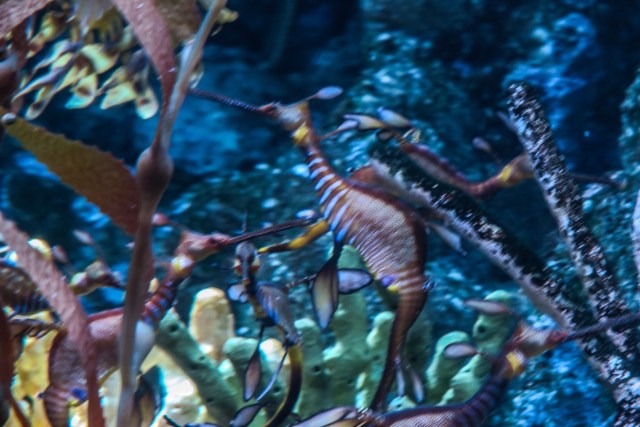Little did I know that our visit to the New England Aquarium was going to include sea dragons and poisonous lion(fish)? No worries, we were never in physical danger but our eyes were assaulted with a visual smorgasboard of unusual creatures and beasties. Here are a few favorites:
JELLYFISH – The gelatinous, brainless, spineless jellyfish is one of the oldest species on earth, arriving millions of years ago, even before the dinosaur. They drift with the currents, or propel themselves by undulating their bell-shaped bodies while pushing water out of their mouths. They make look harmless but most contain some sort of stinging cells in their tentacles to stun their prey. Some jellies are quite poisonous – I’ll be talking more specifically about them in a later post.
Previous attempts to photograph jellies have not been particularly successful but the tanks containing these were backlit, providing perfect illumination:
I was quite happy to be beyond the reach of those nasty looking massive tentacles.
CUTTLEFISH – There is a multitude of strange-looking underwater animals and this next one is a great example. How many of you had parakeets or other pet birds growing up? Do you remember placing a hard white thin slab into the cages as a source of calcium?
It is called a cuttlebone – it is a porous material made from material called aragonite, a crystallized form of calcium carbonate. It is also a critical part of a cuttlefish’s anatomy that helps its buoyancy. Here are my photos of these odd-looking but very intelligent mollusks:
These are not photos of two cuttlefish doing synchronized swimming – the upper image is a reflection on the water.
Above shot courtesy of Lenore.
If you think the cuttlefish’s tentacles make it look a bit like a squid or octopus, you are not far off – they are cousins of a sort, all belonging to the family “cephalopods.”
This next fish is beautiful but as is the case with many brightly colored underwater animals, its colors and ornamentation are a warning – it is highly poisonous.
LIONFISH – Growing up to 15 inches, the lionfish uses its striped camouflage to hide its approach to its prey – small shrimp, crabs and other fish living in its coral reef and shallow bay habitats. Those long spikes are quite venomous, so most potential predators avoid the lionfish. The lionfish belongs to the “scorpionfish” family which includes some of the most dangerously venomous fish in the ocean. So look, but DO NOT TOUCH!!!
SEAHORSES – Saving my favorite for last, seahorses are not poisonous or at all dangerous. They are delicate, tiny defenseless animals, clinging to seaweed or seaplants with their tails or swept along underwater currents. Seahorse males are the ones responsible for their progeny, as the female deposits up to 1500 eggs into a pouch on the front of the male which carries the eggs for up to 45 days before fully formed babies are birthed.
The seahorse tries to hide among the grasses and seaweed, staying motionless to avoid detection. They have cousins, however that have taken camouflage to the next level: the seadragon.
There are two species of seadragons, the leafy and the weedy and you will immediately see why they are truly the masters of disguise. It was quite difficult to photograph the seadragons as they wove back and forth and despite my best attempts at photoedting these photos are not as sharp as I would like – but perhaps that only shows how well these seadragons are camouflaged.
The above two shots courtesy of Lenore.
More underwater adventures to come.
#



























Beautiful pics. Love it.
Thank you! Super photos and descriptions as always😘
Thank you! Super photos and descriptions as always😘
You and Lenore have become amazing photographers. The pictures are beautiful. Thanks for sharing.
Thanks Manya – you know I hate waiting for anything – but nature photography has taught me patience – and its worth it!